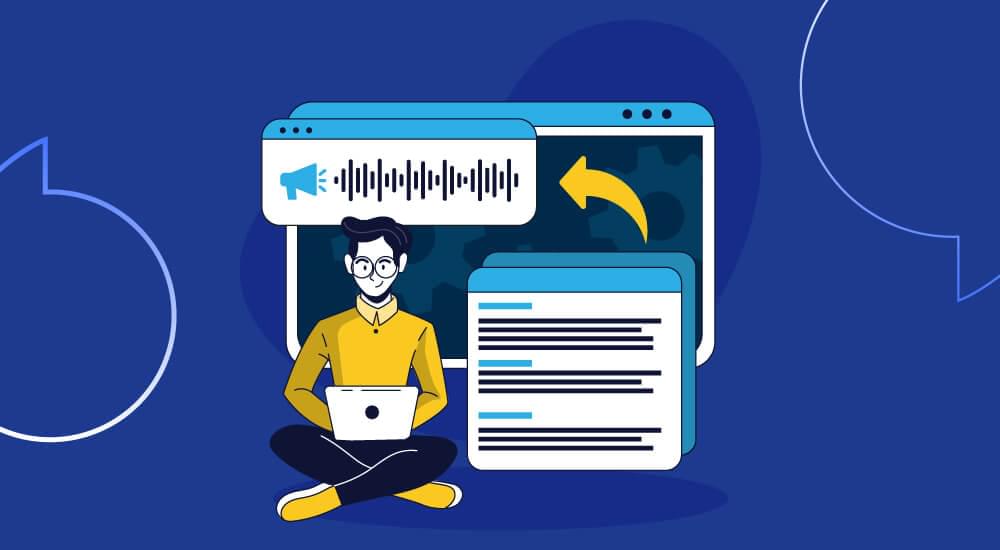voice technology tutorials
What is conversational marketing? Tips and examples explained
After the big-time hit of Augmented reality and Virtual Reality involving video content to promote literally everything, its time for audio technology to be next big hit. From digital transformation, financing, accessibility of information and automation of tasks—audio technology is everywhere.
Conversational marketing is the subtraction of audio technology—a customer-centric or dialogue-driven approach to market products and services. It is a go-to strategy to boost user engagement, improve user experience, and grow revenue.
The name itself is explainable about the term already—but if you’re wondering how conversational marketing can work for your business, how it’s so crucial in 2022, and where it fits in with the world of inbound, keep on reading!
What is conversational marketing?
Conversational marketing is the enabler of one-to-one interactions in real-time across multiple channels. It empowers you to foster customer relationships and enhance your online user experience through direct communication and by customizing online interactions.
Live chat, chatbots, reading apps, and messaging apps are used to enable these personalized business conversations.
Audio tools, in particular, have created conversational marketing more accessible. The two solutions work altogether as the same thing, but speech tools are just a part of conversational marketing.
One-to-one communication, like phone and email, can be an integral part of conversational marketing strategy. Today, voice assistants and speech tools or chatbot messenger are the most popular way to reach out to users and target audiences. People love to speak about the details of the products and services and want instant responses. Therefore, voice assistants, speech tools, and voice chatbots are popular. For instance, WhatsApp is also famous for direct assistance for a specific product.
The main thing in conversational marketing is assessing and comprehending your users’ preferred channels and adapting your tone of voice accordingly—talking through chatbots, or live chat is informal and mimics a casual conversation.
Conversational marketing VS. inbound marketing
What’s the difference between inbound and conversational marketing?
Conversational marketing often involves an integral part of an inbound marketing strategy. At the same time, inbound is the “pull” tactic of attracting customers through their preferred channels. On the other hand, conversational marketing is conversing with customers through preferred media.
It is one of the easiest and most accessible ways to interact with customers by offering the power of when, how, and where they communicate with your business. Both ways are seamless, customer-centric, and go hand-in-hand.
Audio tools in conversational marketing
Thousands of companies turned to audio technology to embrace agility and resilience and recover from sagging sales and flagging profits.
Hundreds of companies were already on the digitization journey for a few years before the pandemic, and they faced themselves more stabilized than those without audio technology.
The world expects to see transformational results after widespread adoption and significant value of voice assistance and speech tools. How is it going to impact the global economy and ways of doing business?
- The experts are cautious over the massive rise in audio tools adoption, and it’s getting more complex.
- The rise in audio tools adoption led companies to self-delusion, as they may have been missing the right focus and real audio technology’s value.
But there are ways of saving your company by capturing the full value of audio technology.
Like any other strategy or a plan to work out well, it takes scalable commitment and execution excellence. Therefore, a successful business transformation needs a well-thought-out plan for you to stay on the list of winners in the cloud.
Chatbots tools in conversational marketing
When talking about conversational marketing, people spontaneously assume chatbots and audio tools & plugins.
Reasonably so, they play a significant role in executing conversational marketing as a communication medium. Chatbots employ a casual approach and simulate face-to-face interactions.
At present, chatbots come in all shapes and sizes with miscellaneous capabilities and tiers of refinement, from chatbots with AI powers to less advanced bots like button-based bots.
In conversational marketing, chatbots are used to automate the process of gathering data, providing information about products/services, and qualifying your leads further.
Chatbots are more and more common on websites and social media handles and are bound to raise audience expectations. Consequently, bots require establishing that they’re efficient in conveying and providing the value users are looking for.

Pros of conversational marketing that are hard to ignore
The reason millions of businesses are jumping onto audio technology and AI-based and automation-powered audio tools is to automate several business and managerial tasks.
Audio tools offer multidimensional benefits when promoting or marketing products and businesses. It’s a great help to automate the marketing processes, especially content making and its promotion on different social media platforms.
1. More exemplary user experience
One of the typical processes begins with web chatbots or audio plugins to initiate the conversation with people who land on your website. These chatbots are useful to offer basic or technical information. These chatbots work in two dimensions; first, they help visitors with the information of what they came looking for. Second, the conversation works as a revealing factor of users’ pain points and gathers the information you need to improve the user experience.
Depending on whatever they’re curious about and where they’re in their buyer’s journey, you’ll be able to revise your marketing strategy, send them relevant information and interact with them in an indicative way.
These meaningful conversations can be run 24/7 to help you build trust in your company throughout the purchasing journey, and further develop relationships with your customers.

2. Lead generation that makes a significant difference
Using the right speech tools, you can find seamless ways to engage your audience, leading to conversion through automated content creation and business marketing strategies. The more quality content you can toss to the digital world on a daily basis, the more likely you can grab the attention of the targeted audience leading to meaningful conversions.
The marketing strategy involving voice helps to make helpful information accessible even to those who can’t read out properly–apps the reads will read out all information in their preferred language.
Apps that read, help in numerous other ways to improve marketing strategy and enhance business prospects.
3. Faster conversion through the sales funnel
Integrating marketing strategy with sales teams can lead you to some real-time business prospects. You can target multiple things such as brand building, product promotions, and ever returning buyers.
Speech tools help the sales team to execute the goals through direct chats that engage users to make bookings on the final details of products, eventually leading to more sales.

4. Set the right conversational marketing goals for your brand
Making the best conversational marketing strategy revolves around automating business tasks helping to achieve business goals seamlessly. Most businesses adopt conversational marketing to achieve multidimensional benefits. Therefore conversational marketing is proving to be bringing more conversions.
5. Choose your social media platforms and define Q&As
Knowing your users and their demands helps determine what kind of social media platforms you need to promote your products and how they relate to your products or services niche, assist in finalizing a buying decision, or upgrade your gated content or demos.
Deciding on what kind of FAQs your bot should cover should be founded on your sales team’s data to qualify a lead.
The nature of FAQs corresponds to your objectives and should be modified at various customer journey stages.
6. Personalize and optimize conversational marketing strategy
Customizing information as per users’ needs and behavior on the website and social media handles at different stages of their customer journey enables you to offer them the right content at the proper channels at the right time.
Audiences appreciate when they see relevant information that resolves their queries and can have authentic interactions. As a result, you’re able to reinforce strong customer relationships.
You have to improve your marketing conversations constantly to get the most out of your process. After pitching a chatbot, it’s all about testing. It would be best if you analyzed the data of the conversations, your customers’ journey, and the level of user attention—and shift in conversation flows founded on the findings.

7. Ask for feedback—to improve, deploy and gain more conversions
Gathering feedback from the audience and prospects plays an important role in further designing a conversational marketing strategy.
It can show the weaknesses and areas of progress, help you create more significant interactions, and further enhance the user experience.
How to use conversational marketing?
Helping companies execute audio channels to gain helpful insight into how to best use conversational marketing and where to get started.
Here are a few pro-tips to assist you if you’re looking to integrate audio plugins, speech-to-text tools implementation and chatbots conversations for your website visitors.
First, carefully choose what queries are crucial, keep them highlighted, and create navigational paths to lead the audience to product demos to make buying decisions.
Executing the conversational marketing strategy begins by picking the essential landing pages to engage with your visitors.
To optimize the number of dealings and your results, select the pages that get high traffic with visitors with a high intention of buying.
Then once you know where you want to have your bot placed, you can move to plan the bot conversation flow.
Based on your conversational marketing strategy and the stages of the customer journey of the page visitors, define what kind of information you need to ask and how many questions are required.
For a good customer experience, try to keep the conversations simple in all of your different conversation flows. People expect the interaction with your company to be smooth and want to get answers and guidance quickly.
Ready to add conversational marketing to your plans?
We hope we’ve convinced you that it’s time to level up your 2022 marketing strategy with the benefits as mentioned above and conversational marketing examples.
Conversational marketing can really help you and your customers throughout the entire online customer journey - from a visitor interested in educating themselves to a prospect looking for information on your products and an existing customer needing support with a new purchase.
Start getting the ready-to-buy qualified leads that you’re looking for, shorten the sales cycles and move your online leads through the buyer’s journey faster. Build trust and develop your customer relationships further with these meaningful interactions.









